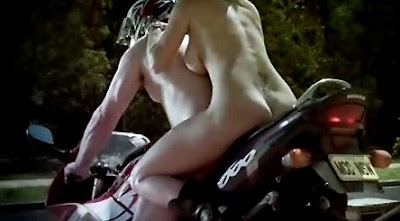
We have all heard the stories or personally know riders that have years of
This only emphasizes the point that when you are riding your motorcycle you have to be constantly evaluating your riding conditions; street surface, traffic patterns,
- Scan
- You should constantly be aware of what's in front, to the sides and behind you. I personally scan constantly, first forward then through the mirrors and to each side and back again; scanning my tach & speed as I go. If you don't already scan or you're new to biking; take time to develop a pattern that includes your mirrors, your controls, and the area ahead of you. You should always be on the lookout for potential hazards and escape routes - even when you are stopped for a
traffic signal/stop sign. When changing lanes be sure to check your mirrors early and often. When slowing to stop, check your mirrors to ensure that othermotorists behind you are aware that you're stopping. One trick that I use to get the attention ofmotorist behind me is to tap my brake (either front or rear) in a 3-1-3 pattern. Maintain a 10-12 second lead. Meaning that you need looking at where you'll be 10-12 seconds from now. - Identify
- Identify the situation ahead. Is there a hazard? Would you consider a side street a hazard? Probably not if you're in your car. Car's are "big"; meaning that their easily spotted by someone wanting access to the main road. Motorcycles are nearly invisible and you need to be aware of that when you ride. The same car on the side street will 99% of the time see the oncoming car, the percentage get's much lower with an oncoming
- 1. Other vehicles sharing the road.
- 2. Pedestrians and animals.
- 3. Stationary objects.
motorcycle . Be ready, change lanes if you can, approach with cautious awareness that they may not see you. Are there multiple hazards ahead? Oncomingtraffic , canyon road, side streets all pose their own risks scan and plan at all times. What are your escape routes? If you need to "ditch" or "lay it down" where? Options? What presents the least threat to you and yoursafety ? Identify each situation by what represents a threat and what represents an opportunity or escaperoute . Themotorcycle safety foundation recommends separating hazards into three separate and distinct categories.
- 1. Other vehicles sharing the road.
With each category representing a different level of risk and each needs to be addressed by the rider differently.
- Learn to anticipate what the hazard is going to do; if it's a deer nature says it's going to get startled. There's a 50/50 chance it will dart in front of you - what's your plan? Once you've formulated a plan (about 0.5sec to do, predict what might happen - I always use the worst case: Of course the deer will dart in front of me - now what? Formulate your escape
- Determine your course of action. Let your presence be known; using the 3-1-3 pattern is one way I make sure that I'm seen. Increase or decrease your speed speed, changing the lane your in or maybe even your direction all together. Combine any or use all three. Some riders put "whistlers" on their bikes, can't be heard by us but it is supposed to keep the deer and other wildlife out of the way. No matter what decision you make, be certain that you've account for your skill/experience level and road conditions.
- Take action based on what you decided to do. If you can, separate the hazards so you're only dealing with one at a time. Continue scanning and adjust your actions based on the situation. Remember riding a motorcycle is fluid and things might change. Concentrate on the
Remember to always be aware of your surroundings. Riding a
Sturgis, Daytona, Laconia, motorcycle safety, motorcycle, riding, route, traffic, insurance, repairs, bike, SPIDE, route
0 comments:
Post a Comment